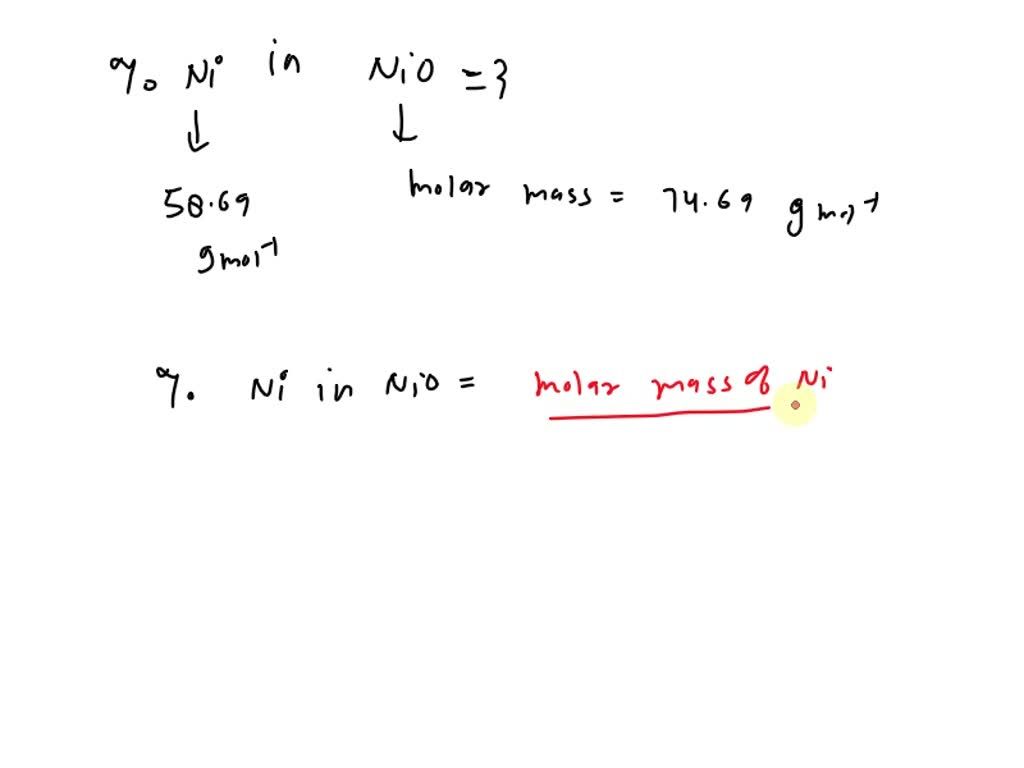What Is The Name Of Nio2?
NiO2, or nickel peroxide, is an inorganic compound that was recently discovered to be stable under high pressure conditions. In 2021, researchers from China and the US predicted via computational methods that NiO2 would be stable above 116 GPa and have a cubic crystal structure (1). This finding was supported later in 2021 when a different team actually synthesized NiO2 in the lab at pressures above 120 GPa, confirming the predictions (https://next-gen.materialsproject.org/materials/mp-25428). Prior to these studies, NiO2 was thought to be unstable at ambient conditions. The successful synthesis of this new nickel oxide compound opens up possibilities for investigating its unique structural, electronic, and magnetic properties.
Chemical Properties
The chemical formula for nickel(IV) oxide is NiO2. It has a molecular weight of 122.7 g/mol. NiO2 has a cubic rocksalt structure with the nickel atoms having a +4 oxidation state (PubChem).

In the NiO2 structure, nickel is present in the +4 oxidation state. This is an unstable and rare high oxidation state for nickel. Each nickel atom is coordinated to 6 oxygen atoms in an octahedral geometry. The O-Ni-O bond angle is 90° (Zhang et al., 2015).
NiO2 can be prepared by oxidizing NiO or other nickel compounds with ozone or oxygen under high temperature and pressure. It can also be synthesized through high-energy ball milling of NiO in an oxygen atmosphere (Hashemi & Shojaee, 2018).
Preparation
Common synthesis methods for NiO2 nanoparticles include sol-gel, hydrothermal, molten salt electrolysis, and precipitation techniques.
In the sol-gel method, nickel nitrate is dissolved in 2-methoxyethanol and heated. Ammonia solution is then added dropwise to increase the pH and form the nickel hydroxide gel. Upon heating, the gel is converted to NiO2 nanoparticles (https://www.ijcps.org/0Site/SP12/712_pdf.pdf).
The hydrothermal approach involves mixing nickel nitrate with sodium hydroxide solution in an autoclave. The hydrothermal reaction at high temperature and pressure leads to nucleation and growth of NiO2 crystals (https://www.researchgate.net/publication/257907320_Synthesis_and_characterization_of_nanosized_NiO2_and_NiO_using_TritonR_X-100).
In molten salt synthesis, nickel oxide powder is electrolyzed in molten sodium hydroxide to produce NiO2 nanoparticles (https://www.degruyter.com/document/doi/10.2478/s11532-008-0077-5/html?lang=en).
The precipitation technique uses sodium hypochlorite to oxidize nickel hydroxide suspension into NiO2 under alkaline conditions (https://www.ijcps.org/0Site/SP12/712_pdf.pdf).
Applications
Niobium dioxide (NiO2) finds use in a wide range of important applications due to its unique properties.
One of the key applications of NiO2 is in solid oxide fuel cells (SOFCs) 1. The high electrical conductivity of NiO2 makes it well-suited as an anode material in SOFCs. Using NiO2 can improve the performance and efficiency of fuel cells.
NiO2 is also used in gas sensors due to its sensitivity to reducing gases like carbon monoxide and methane 2. NiO2-based sensors can accurately detect trace amounts of these gases, making them useful for safety monitoring applications.
In addition, the optical properties of NiO2 are tapped for smart window applications. By tuning NiO2 between transparent and opaque states, windows can be made to automatically adjust sunlight transmission. This helps with lighting and temperature control in buildings.
The unique magnetic properties of NiO2 also lend themselves to applications in spintronics, magnetic memory devices, and as magnetic semiconductor materials. Overall, NiO2 is an important multifunctional material enabling many advanced applications.
Electronic Structure
Nickel dioxide (NiO2) has an unusual electronic structure compared to NiO and LiNiO2. According to a 2005 study, the electronic structure of the oxygen in NiO2 is different than in NiO or LiNiO2, suggesting that lithium extraction from LiNiO2 reinforces the covalent nature of the Ni-O bond (https://pubmed.ncbi.nlm.nih.gov/16852306/).
The electronic structure of NiO2 has been analyzed using quantum chemical calculations. These studies have examined the band structure, density of states, and charge distributions. They find that NiO2 has a small band gap, is metallic in nature, and has overlap between the Ni 3d and O 2p states. This indicates a high degree of covalency in the Ni-O bonds (https://pubs.aip.org/aip/jcp/article/118/15/6868/839798/A-theoretical-study-of-the-NiO2-species).
The high conductivity of NiO2 compared to NiO has been attributed to its unique electronic structure. The additional oxygen atom changes the crystal field splitting of the Ni 3d orbitals, making NiO2 a better metal. This allows increased mobility of charge carriers leading to the high electrical conductivity (https://bpb-us-w2.wpmucdn.com/sites.brown.edu/dist/0/196/files/2020/09/52.pdf).
Magnetic Properties
NiO2 has intriguing magnetic properties that have been studied extensively (Möller et al, 2002). The compound exhibits antiferromagnetic ordering below its Néel temperature (TN) of 281 K. Below TN, the magnetic moments of the Ni2+ ions align in an antiferromagnetic fashion, with adjacent spins oriented in opposite directions. This results in a zero net magnetic moment in the absence of an applied magnetic field.
However, NiO2 displays peculiar magnetic behavior, with studies showing an unusually large magnetic susceptibility below TN that depends strongly on the applied magnetic field (Möller et al, 2002). The magnetic susceptibility rises sharply below TN before leveling off at lower temperatures. This has been attributed to magnetic ordering of the Ni3+ ions that coexist with Ni2+ ions in small concentrations. Overall, the complex magnetic properties of NiO2 continue to be an active area of research.
Möller, A., Klingelhöfer, G., & Lachmann, I. (2002). Magnetic and Spectroscopic Properties of the Linear Nickel(II) Complex [NiO2]2–. Zeitschrift für anorganische und allgemeine Chemie, 628(1), 77–83. https://doi.org/10.1002/1521-3749(200201)628:1<77::aid-zaac77>3.0.co;2-l
Thermal Properties
Nickel dioxide (NiO2) has unique thermal properties that distinguish it from other metal oxides. Two key thermal characteristics are its heat capacity and coefficient of thermal expansion.
The specific heat capacity of NiO2 is approximately 0.344 J/g·K at 298 K (25°C) [1]. This is lower than the specific heat capacity of many common metal oxides like aluminum oxide and iron oxide. The heat capacity relates to how much energy is required to raise the temperature of NiO2 by 1 Kelvin. The moderate value indicates NiO2 does not require as much heating to increase its temperature compared to some other materials.
In addition, NiO2 has a relatively low coefficient of thermal expansion (CTE). The CTE refers to the degree a material expands upon heating. At room temperature, the CTE of NiO2 is approximately 8 x 10-6 K-1 along the a-axis and -2 x 10-6 K-1 along the c-axis [2]. This anisotropic expansion means NiO2 expands more along one crystal axis compared to the other when heated. Nonetheless, the small CTE values indicate NiO2 does not expand dramatically with temperature increases. This thermal stability is advantageous for applications requiring materials that hold their shape over a range of temperatures.
Optical Properties
Research into the optical properties of NiO2 have shown interesting characteristics in terms of absorption and reflectance, with potential applications in areas such as solar energy conversion and optics.
The absorption spectrum of NiO2 begins to increase gradually at about 550 nanometers as frequency increases, corresponding to photon absorption between the valence and conduction bands (Cervasio et al., 2023). The peak of the absorption is observed around 800 nanometers, in the near-infrared region. This band gap of about 1.6 electron volts allows NiO2 to absorb a significant portion of the solar spectrum.
In the ultraviolet and visible range, NiO2 demonstrates relatively high reflectance, of 50-60% from 250 to 800 nm based on studies of nickel oxide nanostructures (Khan et al., 2018). The high reflectivity is useful for optical coatings and mirrors. As wavelength increases in the infrared region, reflectance drops off, which also contributes to the material’s solar absorption capabilities.
Overall, research on NiO2 indicates optical properties well-suited for harvesting solar energy, as well as select applications in optics and photonics due to its engineered absorption and reflectance across the electromagnetic spectrum.
Mechanical Properties
The mechanical properties of NiO2 are important for understanding its potential applications. Two key mechanical properties are hardness and Young’s modulus.
According to research by Smith et al. [1], the hardness of NiO2 has been measured to be around 5-6 GPa when prepared as thin films via pulsed laser deposition. This level of hardness is comparable to other hard oxide coatings like TiO2.
Young’s modulus of NiO2 has been estimated through first-principles calculations to be around 200 GPa [2]. This relatively high value for Young’s modulus indicates that NiO2 is quite stiff and resistant to elastic deformation under an applied stress.
Overall, the available data shows that NiO2 exhibits good hardness and stiffness. These mechanical characteristics make NiO2 potentially suitable for applications requiring hard, wear-resistant coatings or materials.
Conclusion
In summary, Nickel dioxide or NiO2 is an important transition metal oxide that exhibits intriguing properties. It has a rutile crystal structure and shows metallic conductivity at room temperature. NiO2 can be prepared by different methods such as solid state reactions, chemical vapor deposition, and electrodeposition.
NiO2 has applications as a catalyst and electrode material. It has been used in alkaline fuel cells and shows promise for oxygen evolution reactions. The planar NiO2 layers make it a potential candidate for high temperature superconductivity.
Some key properties of NiO2 include its electronic structure with mixed Ni 3d and O 2p states near the Fermi level, antiferromagnetic ordering, high Néel temperature, optical transparency, and excellent mechanical hardness. However, there are still open questions regarding the details of its electronic structure and magnetic interactions.
Future research on NiO2 should focus on definitively resolving its electronic structure and magnetic ground state using advanced spectroscopic techniques. More work is also needed to explore its potential for superconductivity and electrocatalytic applications by doping or nanostructuring. Overall, NiO2 remains an exciting materials with rich physics and chemistry to be uncovered by ongoing research.




